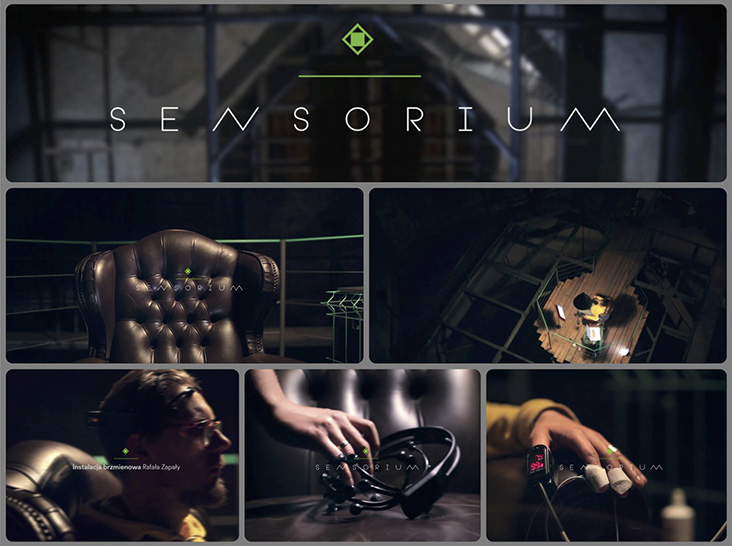Promotion
Sensorium
The origin
The Sensorium installation is the effect of the author’s traineeship at Stanford University’s CCRMA Institute. During the visit, technological and programming foundations were laid, installation sketches were made, as well as technologies and particular devices used were selected.
First edition was created on request of "The Castle" Culture Centre in Poznań (Poland). The sound installation filled the monumental, disused, empty space of the Clock Tower situated in the very heart of the city.
The 45 min. session was attended individually in the keeping of a Silent Assistant. The Visitor was surrounded by spherically projected music.
Within the framework of this programme, a research-artistic team was formed, research and creative work carried out, and prototype music created.
Besides the Sensorium in the castle tower, an educational programme which consisted in lectures, workshops and a conference (of which the present publication constitutes an element), also formed a part of the project. The same approach could be considered in each individual case.
A simple idea
The idea was clear, minimalistic and simple. What I imagined was not a museum-type work of art, but rather a special social space, a kind of urban facility. I imagined the visitor sitting alone inside the huge, monumental space of the empty Clock Tower in the very centre of the city. He is surrounded by music, and can control it with bio-physical data (with mind, skin of the left hand, heart rate). He can influence the soundscape with conscious or unconscious decisions and with emotions. As simple as this.
In other words The Sensorium is an intimate, one-person experience of "anti-mass" character. It will essentially consist in transposition of the structure and dynamics of visitor’s emotional psychophysical reactions (by means of biofeedback technology in the tradition of Alvin Lucier’s work) upon musical structures in a direct “live” experience.
During the session, when our software-program gives instructions to the visitor, it constitutes a better description of the project:
“Sound installation Sensorium, which is based on bio- and neurofeedback technology, is an instrument which you play with your brain, the skin of your left hand, and your heart. You should be aware that you are not only able to control their actions, but also to improve this skill. We don't ask you any questions, but we have built a system that requires your participation, you are the core of this installation. So be active and creative - open and close your eyes, hold or accelerate your breath, visualize relaxing images or try to perform complex calculations.
You will hear several musical layers, each of them reacts to a different sensor. For example the level of your engagement will be represented by the grand piano and other percussive sounds, while the data from your EEG will be heard in the form of strings and voices.
The sounds are organized in a particular manner. In the state of relaxation and low-key emotions the sounds are in punctualism style and appear chaotic. In the medium range of emotions music begins to present itself in the manner of rhythmical and repetitive loops, while in the state of intense emotions it becomes a massive cloud of sounds. When you reach the tower, an assistant will equip you with three sensors: a GRS on your left-hand fingers, an ECG on your thumb, and an EEG on your head. Let him do it, it is essential that the installation works properly.“

Site-specific work
Sensorium is understood as an open artistic, research, social and urban development project. The aim is to make each new Sensorium as embedded in the fabric of the city as possible. Key elements must be preserved of course, but site-specific character is very important. There are 5 main aspects to achieve this:
1. Venue.
We seek places that are important for the town, and boast "a past”, e.g. abandoned or temporarily disused facilities (religious, industrial), in highly urbanised parts of towns (meditation within metropolises). Besides elements of the set (platform, armchair, amplification, electronics), we assume potential revitalisation of such a venue to return it to life as a new cultural space. This is what happened in Poznań.
2. Music.
Rafał Zapała's assumption is to compose completely new music that will be unique for each Sensorium. The idea is to co-create it with musicians from the selected city. It would be great to involve an excellent contemporary music ensemble. But different genres of music can be considered as well like free improvisation, jazz or modern rock (rafał Zapała's goal is to avoid electronic music – he considers that "acoustic", instrumental approach is more accurate in this work).
3. Silent Assistants (between 2 and 8).
They are the live tissue of the installation: "actors" in a performance, "guides", "technicians" who operate the program, "laboratory technicians" who put the sensors in place, "researchers" testing the operation of the whole. Upon training, they are silent witnesses to one-hour sessions during which the visitor tries to hear his emotions. They should be natives from the area.
4. Local internet domain and it's own website of each new version of the installation (e.g. www.sensorium.poznan.pl)
5. Curator (an organization of culture, a festival, municipal authorities) – a partner and co-creator.
Financing
Sensorium is not museum-type artwork. It is rather new kind of urban facility for citizens, for new type of contact with the music. Budget is here an important thing, and depends very much on the scale of the installation. We have spent about 15000€ for previous monumental installation in Poznan (incl. music, programming, scenography, architectural interventions, equipment, website, promotion, educational program etc.). But it's ALWAYS site-specific work. Final budget may be very different. We have opened some disscussions with Polish partners (Polish Institutes in the world, Adam Mickiewicz Institute, various commercial companies). Having an interesting, intriguing vanue, and a strong local partner, theese talks will surely be very fruitful.